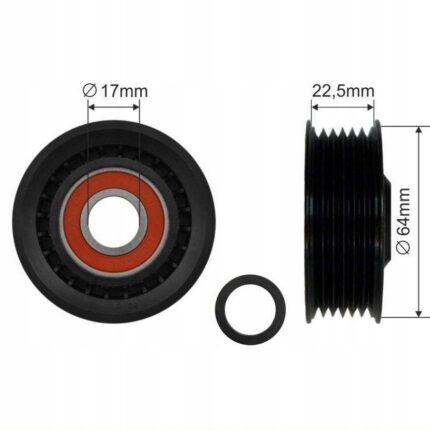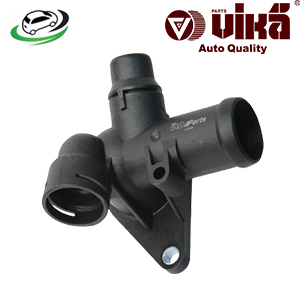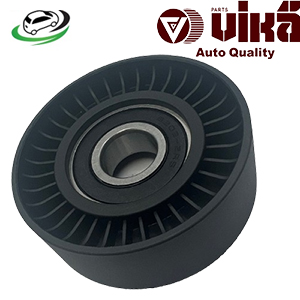-14%
Get Serpentine Belt Tensioner Assembly Audi TT 2000-06/TT Quattro 2000-06 / VW Beetle 1998-05/Golf 1999-06/VW Jetta 1999-05 06A903315D
The belt tensioner and idler pulley are crucial components of a vehicle’s engine system. They ensure the proper tension and routing of the serpentine belt, which drives multiple peripheral devices such as the alternator, power steering pump, water pump, and air conditioning compressor. This guide provides an in-depth look at the belt tensioner and idler pulley, including their functions, types, common issues, maintenance, and replacement.
Function of the Belt Tensioner and Idler Pulley
Belt Tensioner
The belt tensioner maintains the correct tension on the serpentine belt to ensure it runs smoothly and efficiently. Key functions include:
- Maintaining Tension: It keeps the serpentine belt at the proper tension, preventing it from slipping or becoming too loose.
- Compensating for Wear: As the belt wears and stretches over time, the tensioner automatically adjusts to maintain the correct tension.
- Reducing Vibration: It helps dampen vibrations from the belt, ensuring smooth operation of the engine accessories.
- Protecting Components: Proper tension reduces wear on the belt and other components, extending their lifespan.
Idler Pulley
The idler pulley guides the serpentine belt around various engine components. Key functions include:
- Guiding the Belt: It helps route the serpentine belt in the correct path around the engine’s accessories.
- Maintaining Alignment: Ensures the belt stays aligned and prevents it from slipping off the pulleys.
- Reducing Friction: Helps minimize friction between the belt and other engine components, promoting efficient operation.
- Supporting the Belt: Provides additional support to the serpentine belt, enhancing its stability and performance.
Types of Belt Tensioners and Idler Pulleys
Belt Tensioners
- Automatic Belt Tensioners:
- Description: Automatically adjust to maintain the correct belt tension.
- Applications: Commonly used in modern vehicles.
- Pros: Require minimal maintenance, provide consistent tension.
- Cons: More complex and expensive than manual tensioners.
- Manual Belt Tensioners:
- Description: Require manual adjustment to maintain the correct belt tension.
- Applications: Used in older vehicles or specific applications.
- Pros: Simpler design, generally less expensive.
- Cons: Require periodic adjustment and maintenance.
Idler Pulleys
- Flat Idler Pulleys:
- Description: Have a flat surface and are used to guide the flat side of the serpentine belt.
- Applications: Common in many engine configurations.
- Pros: Simple design, effective in guiding flat belts.
- Cons: Limited to specific belt orientations.
- Grooved Idler Pulleys:
- Description: Have grooves that match the ribbed side of the serpentine belt.
- Applications: Used to guide the ribbed side of the belt.
- Pros: Provide better grip and alignment for ribbed belts.
- Cons: More specific to belt types and orientations.
Importance of Belt Tensioners and Idler Pulleys
Belt tensioners and idler pulleys are essential for several reasons:
- Preventing Belt Slippage: Proper tension and guidance prevent the serpentine belt from slipping off the pulleys, ensuring the continuous operation of engine accessories.
- Extending Belt Life: By maintaining the correct tension and alignment, these components help reduce wear and extend the lifespan of the serpentine belt.
- Enhancing Engine Performance: Properly functioning tensioners and pulleys ensure that engine accessories operate smoothly, contributing to overall engine performance.
- Reducing Maintenance Costs: Preventing premature belt wear and component failure can reduce the frequency and cost of maintenance and repairs.
Common Issues with Belt Tensioners and Idler Pulleys
Several issues can affect the performance and longevity of belt tensioners and idler pulleys:
- Wear and Tear: Over time, the components can wear out due to constant use and exposure to engine heat and vibrations.
- Noise: Squeaking or chirping noises from the engine bay can indicate a failing tensioner or idler pulley.
- Belt Slippage: If the tensioner fails to maintain proper tension, the belt can slip off the pulleys or become misaligned.
- Seized Bearings: Bearings inside the tensioner or idler pulley can seize, causing the pulley to stop spinning and potentially damaging the belt.
- Cracks and Breaks: Physical damage to the tensioner or pulley can lead to failure and require immediate replacement.
Signs of a Faulty Belt Tensioner or Idler Pulley
Identifying signs of a faulty tensioner or idler pulley can help address issues before they lead to more severe problems:
- Unusual Noises: Squeaking, chirping, or grinding noises from the engine bay can indicate a worn or damaged tensioner or pulley.
- Belt Wear: Excessive or uneven wear on the serpentine belt can be a sign of improper tension or misalignment.
- Belt Slippage: If the belt slips off the pulleys or shows signs of misalignment, the tensioner or pulley may be at fault.
- Vibrations: Excessive vibrations from the engine bay can indicate a failing tensioner or pulley, affecting the smooth operation of engine accessories.
Maintenance and Prevention
Proper maintenance of belt tensioners and idler pulleys can help ensure their longevity and effectiveness:
- Regular Inspection: Check the tensioner and pulleys for signs of wear, damage, or misalignment during routine maintenance.
- Replace Worn Components: Replace any worn or damaged tensioners or pulleys promptly to prevent further issues and maintain proper belt tension.
- Monitor Belt Condition: Regularly inspect the serpentine belt for signs of wear, cracks, or damage, and replace it if necessary.
- Proper Installation: Ensure that tensioners and pulleys are installed correctly, following manufacturer specifications and guidelines.
Replacement of Belt Tensioners and Idler Pulleys
Replacing a belt tensioner or idler pulley involves several steps, which can vary depending on the engine type and configuration:
- Preparation:
- Tools and Materials: Gather necessary tools, including a socket set, wrenches, and replacement parts.
- Safety Measures: Ensure the engine is cool and the vehicle is securely supported.
- Remove the Serpentine Belt:
- Locate Tensioner: Identify the belt tensioner and use a wrench or socket to release the tension on the serpentine belt.
- Remove Belt: Carefully slide the belt off the pulleys and set it aside.
- Remove the Old Tensioner or Pulley:
- Locate Component: Identify the tensioner or idler pulley that needs replacement.
- Remove Fasteners: Use a socket set or wrenches to remove the bolts securing the tensioner or pulley to the engine.
- Remove Component: Carefully remove the old tensioner or pulley from the engine.
- Install the New Tensioner or Pulley:
- Prepare the Area: Clean the mounting area to remove any debris or old sealant.
- Install Component: Position the new tensioner or pulley and secure it with the appropriate bolts, tightening them to the manufacturer’s specifications.
- Reinstall the Serpentine Belt:
- Route Belt: Carefully route the serpentine belt around the pulleys according to the engine’s belt routing diagram.
- Tension Belt: Use the belt tensioner to apply the correct tension to the serpentine belt.
- Check for Proper Installation:
- Inspect: Ensure the belt is properly routed and aligned, and check for any signs of misalignment or improper tension.
- Test Engine: Start the engine and let it run for a few minutes, monitoring for any unusual noises or vibrations.
Follow us on Facebook for more parts.



